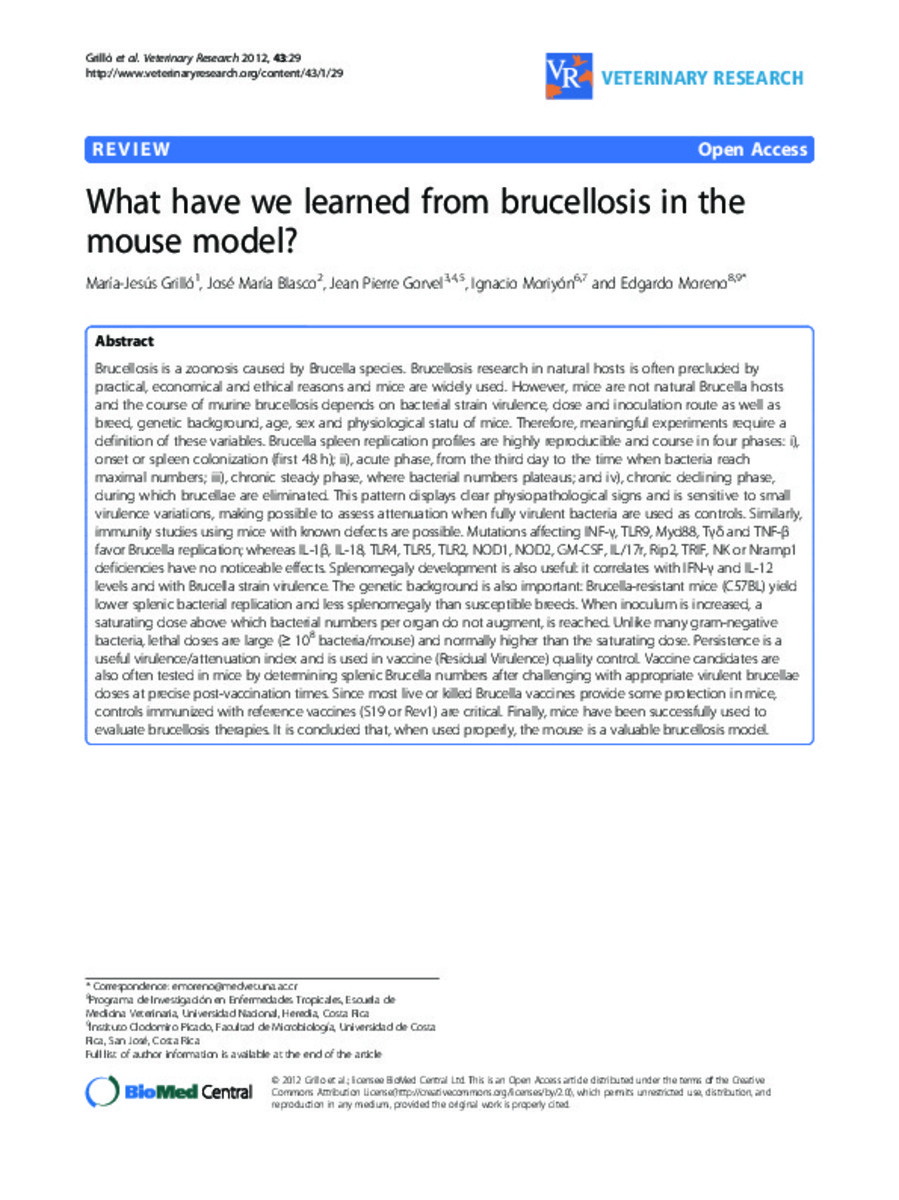Full metadata record
| DC Field | Value | Language |
|---|---|---|
| dc.creator | Grillo, M.J. (María Jesús) | - |
| dc.creator | Blasco, J.M. (J. M.) | - |
| dc.creator | Gorvel, J.P. (Jean Pierre) | - |
| dc.creator | Moriyon, I. (Ignacio) | - |
| dc.creator | Moreno, E. (Edgardo) | - |
| dc.date.accessioned | 2013-07-02T11:51:33Z | - |
| dc.date.available | 2013-07-02T11:51:33Z | - |
| dc.date.issued | 2012 | - |
| dc.identifier.citation | Grillo MJ, Blasco JM, Gorvel JP, Moriyon I, Moreno E. What have we learned from brucellosis in the mouse model? Vet Res 2012 Apr 13;43(1):29-9716-43-29. | es_ES |
| dc.identifier.issn | 0928-4249 | - |
| dc.identifier.uri | https://hdl.handle.net/10171/29479 | - |
| dc.description.abstract | Brucellosis is a zoonosis caused by Brucella species. Brucellosis research in natural hosts is often precluded by practical, economical and ethical reasons and mice are widely used. However, mice are not natural Brucella hosts and the course of murine brucellosis depends on bacterial strain virulence, dose and inoculation route as well as breed, genetic background, age, sex and physiological statu of mice. Therefore, meaningful experiments require a definition of these variables. Brucella spleen replication profiles are highly reproducible and course in four phases: i), onset or spleen colonization (first 48 h); ii), acute phase, from the third day to the time when bacteria reach maximal numbers; iii), chronic steady phase, where bacterial numbers plateaus; and iv), chronic declining phase, during which brucellae are eliminated. This pattern displays clear physiopathological signs and is sensitive to small virulence variations, making possible to assess attenuation when fully virulent bacteria are used as controls. Similarly, immunity studies using mice with known defects are possible. Mutations affecting INF-gamma, TLR9, Myd88, T gamma delta and TNF-beta favor Brucella replication; whereas IL-1 beta, IL-18, TLR4, TLR5, TLR2, NOD1, NOD2, GM-CSF, IL/17r, Rip2, TRIF, NK or Nramp1 deficiencies have no noticeable effects. Splenomegaly development is also useful: it correlates with IFN-gamma and IL-12 levels and with Brucella strain virulence. The genetic background is also important: Brucella-resistant mice (C57BL) yield lower splenic bacterial replication and less splenomegaly than susceptible breeds. When inoculum is increased, a saturating dose above which bacterial numbers per organ do not augment, is reached. Unlike many gram-negative bacteria, lethal doses are large (>= 10(8) bacteria/mouse) and normally higher than the saturating dose. Persistence is a useful virulence/attenuation index and is used in vaccine (Residual Virulence) quality control. Vaccine candidates are also often tested in mice by determining splenic Brucella numbers after challenging with appropriate virulent brucellae doses at precise post-vaccination times. Since most live or killed Brucella vaccines provide some protection in mice, controls immunized with reference vaccines (S19 or Rev1) are critical. Finally, mice have been successfully used to evaluate brucellosis therapies. It is concluded that, when used properly, the mouse is a valuable brucellosis model. | es_ES |
| dc.language.iso | eng | es_ES |
| dc.publisher | BioMed Central | es_ES |
| dc.rights | info:eu-repo/semantics/openAccess | es_ES |
| dc.subject | Experimental murine brucellosis | es_ES |
| dc.subject | Delayed-type hypersensitiviy | es_ES |
| dc.subject | Acquired cellular resistance | es_ES |
| dc.subject | Endogenous gamma-interferon | es_ES |
| dc.subject | Melitensis-infected mice | es_ES |
| dc.subject | Outer-membrane proteins | es_ES |
| dc.subject | Live vaccine candidate | es_ES |
| dc.subject | General control method | es_ES |
| dc.subject | Toll-like receptor-4 | es_ES |
| dc.subject | Abortus-virb mutant | es_ES |
| dc.title | What have we learned from brucellosis in the mouse model? | es_ES |
| dc.type | info:eu-repo/semantics/article | es_ES |
| dc.type.driver | info:eu-repo/semantics/article | es_ES |
| dc.identifier.doi | http://dx.doi.org/10.1186/1297-9716-43-29 | es_ES |
Files in This Item:
Statistics and impact
Items in Dadun are protected by copyright, with all rights reserved, unless otherwise indicated.






